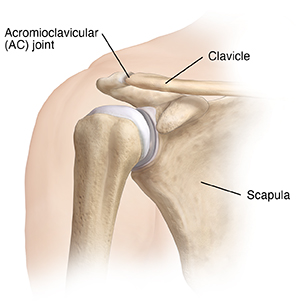AC Arthritis (Acromioclavicular Arthritis)
Arthritis is a type of damage to a joint that can cause inflammation. AC arthritis affects the acromioclavicular (AC) joint. This joint joins the shoulder blade (scapula) and the collarbone (clavicle). The joint has ligaments and cartilage. Various things can inflame the area around the joint. The damage is done by wear and tear over time or other causes. It can lead to pain, swelling, and a stiff feeling in the joint. This can limit a person’s range of motion. AC arthritis is fairly common in older adults.

What causes AC arthritis?
AC arthritis can be caused by:
-
Osteoarthritis. This happens from gradual wear and tear. Over time, the outer cartilage of the joint is worn away. That causes the bones of the joint to scrape together. It leads to stiffness, limited motion, pain, and inflammation.
-
Rheumatoid arthritis (RA). This is an autoimmune disorder. It occurs when the immune system attacks the lining of the joint. This leads to pain, limited motion, and inflammation.
-
Injury to the joint. This can be a break (fracture) or a shoulder separation. For example, a shoulder separation damages the ligaments around the AC joint. The bones may no longer line up right. They may also scrape against each other. This can cause inflammation, limited motion, and pain.
-
Bacterial infection of the joint. This can cause sudden and severe inflammation of the joint.
Certain things may raise your risk for AC arthritis. These include:
-
Older age
-
Arthritis in other joints
-
Family history of arthritis
-
Injury of your AC joint in the past
-
A history of AC joint overuse
-
A weak immune system, which raises the risk for joint infection
-
Use of illegal IV (intravenous) medicines, which raises the risk for joint infection
Symptoms of AC arthritis
In most cases, the symptoms of AC arthritis start slowly and get worse with time. Some common symptoms include:
-
Pain at the top of the shoulder that may spread to the side of the neck
-
Snapping or clicking sound as you move your shoulder
-
Limited range of motion, such as when lifting up your arm
Your symptoms might get worse with certain activities that use the joint. For example, lifting something over your head might cause pain. Crossing your arm in front of your body might hurt. Over time, the joint pain may even keep you from sleeping well at night, especially when you lie on that shoulder.
Many people who have AC arthritis have symptoms in other joints or parts of the body. For example, if you have osteoarthritis, you may also have arthritis of your fingers, knees, or hips. People with RA also often get symptoms in several joints. If you have RA, you may have problems with other organs such as your heart and lungs. And a person with a joint infection may have very sudden symptoms with fever and a lot of swelling.
Diagnosing AC arthritis
AC arthritis can be diagnosed by your primary healthcare provider. Or it may be diagnosed by an orthopedic healthcare provider or rheumatologist. Your provider will ask about your health history and your symptoms. They will give you a physical exam. This will include a careful exam of the shoulder, arm, and collarbone. It will likely include a test of your range of motion, your strength, and joint pain. Your healthcare provider may check your whole body for joint problems.
Your healthcare provider may also order imaging tests. These are to help diagnose the cause of your arthritis and to see how severe it is. An X-ray is the most common first test. You may also need other tests, such as:
-
Bone scan, to get more information
-
MRI, if more detail is needed
-
Injection of a pain medicine or steroid in the joint (diagnostic injection)
-
Ultrasound of the joint, often done at the same time as a diagnostic injection
Treatment for AC arthritis
Your healthcare provider may advise these treatments for your AC arthritis:
-
Changing the way you move your arm to prevent pain
-
Taking over-the-counter pain medicines
-
Doing physical therapy exercises
-
Icing your shoulder a couple of times a day
-
Taking a medicine to treat rheumatoid arthritis, if you have RA
-
Having corticosteroid injections in the joint to ease inflammation
If you still have severe symptoms after trying other treatments, your healthcare provider may talk with you about surgery. An orthopedic healthcare provider might advise a surgery called distal clavicle resection. This surgery takes out a small amount of bone from the end of the collarbone. The bone then no longer scrapes the other bones of the joint. Your healthcare provider may do this through a small cut or incision, using small tools and a tiny camera. Talk with your healthcare provider about the benefits and risks of this surgery.